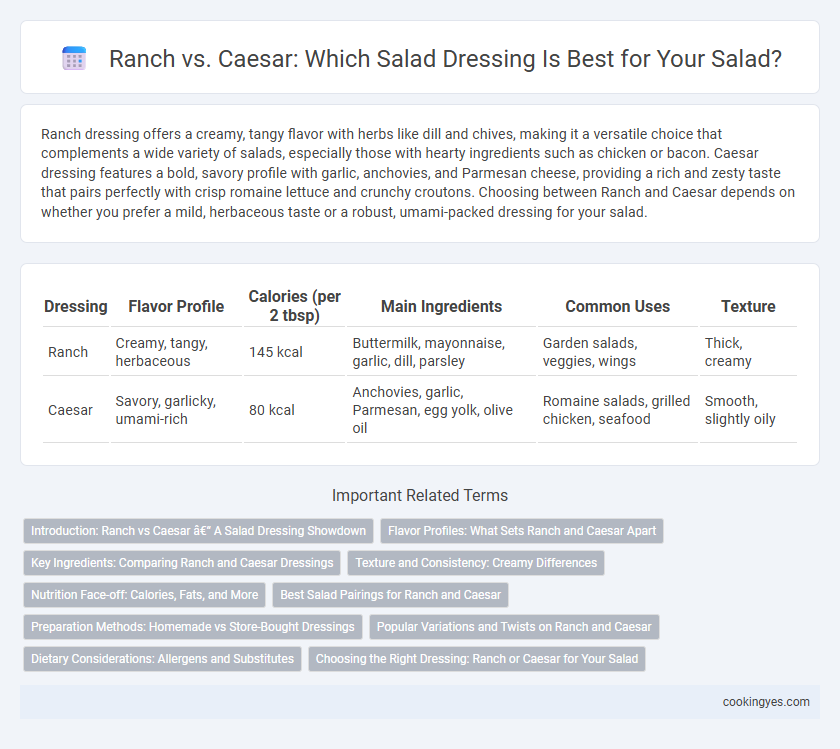Ranch dressing offers a creamy, tangy flavor with herbs like dill and chives, making it a versatile choice that complements a wide variety of salads, especially those with hearty ingredients such as chicken or bacon. Caesar dressing features a bold, savory profile with garlic, anchovies, and Parmesan cheese, providing a rich and zesty taste that pairs perfectly with crisp romaine lettuce and crunchy croutons. Choosing between Ranch and Caesar depends on whether you prefer a mild, herbaceous taste or a robust, umami-packed dressing for your salad.
Table of Comparison
| Dressing | Flavor Profile | Calories (per 2 tbsp) | Main Ingredients | Common Uses | Texture |
|---|---|---|---|---|---|
| Ranch | Creamy, tangy, herbaceous | 145 kcal | Buttermilk, mayonnaise, garlic, dill, parsley | Garden salads, veggies, wings | Thick, creamy |
| Caesar | Savory, garlicky, umami-rich | 80 kcal | Anchovies, garlic, Parmesan, egg yolk, olive oil | Romaine salads, grilled chicken, seafood | Smooth, slightly oily |
Introduction: Ranch vs Caesar – A Salad Dressing Showdown
Ranch and Caesar dressings are two of the most popular choices for enhancing salad flavors, each offering distinct taste profiles and ingredient compositions. Ranch dressing is creamy with a tangy blend of buttermilk, garlic, and herbs, ideal for those who prefer a rich yet mild flavor. Caesar dressing features a bold, savory mix of anchovies, Parmesan cheese, lemon, and garlic, creating a zesty and umami-packed option for classic Caesar salads.
Flavor Profiles: What Sets Ranch and Caesar Apart
Ranch dressing offers a creamy, tangy flavor profile with hints of buttermilk, garlic, and herbs like dill and chives, providing a smooth and mild taste that complements a variety of salad ingredients. Caesar dressing stands out with its bold, savory notes derived from Parmesan cheese, anchovies, garlic, and Worcestershire sauce, delivering a rich umami flavor and a slightly tangy finish. These distinct flavor profiles make Ranch ideal for those who prefer a milder, herb-infused dressing, while Caesar appeals to fans of intense, salty, and creamy tastes.
Key Ingredients: Comparing Ranch and Caesar Dressings
Ranch dressing features key ingredients such as buttermilk, mayonnaise, garlic, onion powder, and fresh herbs like dill and parsley, providing a creamy and tangy flavor profile. Caesar dressing primarily consists of olive oil, egg yolk, anchovies, Parmesan cheese, garlic, and lemon juice, delivering a rich, savory, and slightly salty taste. The distinct ingredient combinations define Ranch's creamy herbaceousness versus Caesar's bold umami and citrus brightness.
Texture and Consistency: Creamy Differences
Ranch dressing offers a thick, creamy texture with a smooth consistency that clings well to salad greens, making every bite rich and flavorful. Caesar dressing, while also creamy, features a slightly thinner texture with a velvety, emulsified base often enhanced by anchovies and Parmesan, giving it a distinctive savory depth. The key difference lies in Ranch's dense, yogurt-like thickness compared to Caesar's lighter, more fluid creaminess, affecting how each coats and interacts with salad ingredients.
Nutrition Face-off: Calories, Fats, and More
Ranch dressing typically contains around 140 calories and 14 grams of fat per two-tablespoon serving, with a higher amount of saturated fats compared to Caesar, which offers about 80 calories and 8 grams of fat for the same portion. Both dressings provide essential fats, but Caesar often includes more protein due to ingredients like Parmesan cheese and anchovies, contributing to its richer nutrient profile. When considering sodium content, Caesar dressing usually contains more, making Ranch a preferable option for those monitoring salt intake.
Best Salad Pairings for Ranch and Caesar
Ranch dressing pairs exceptionally well with crisp iceberg or romaine lettuce, cucumbers, cherry tomatoes, and crunchy toppings like bacon bits or shredded cheddar, enhancing the creamy and tangy flavor profile. Caesar dressing complements hearty greens such as romaine or kale, combined with grilled chicken, Parmesan cheese, and crunchy croutons, creating a rich and savory taste. Choosing the right dressing elevates the salad experience, making Ranch ideal for fresh vegetable salads and Caesar perfect for protein-rich, textured greens.
Preparation Methods: Homemade vs Store-Bought Dressings
Ranch dressing typically combines buttermilk, mayonnaise, garlic, onion, and herbs like dill and chives, either freshly mixed at home or produced in large batches for commercial sale. Caesar dressing involves emulsifying egg yolks, olive oil, anchovies, garlic, lemon juice, and Parmesan cheese, with homemade versions offering richer flavors and fresher textures compared to store-bought alternatives often containing preservatives. Homemade dressings for both Ranch and Caesar deliver superior taste and texture through fresh ingredients, while store-bought options provide convenience and extended shelf life.
Popular Variations and Twists on Ranch and Caesar
Ranch salad dressing often features popular variations such as spicy chipotle ranch and avocado ranch, which introduce smoky and creamy elements to the classic tangy base. Caesar dressing twists include adding anchovy paste, roasted garlic, or substituting traditional Parmesan with Pecorino Romano for a sharper, saltier flavor profile. Both dressings can be customized with ingredients like fresh herbs, lemon zest, or yogurt to enhance texture and nutritional value.
Dietary Considerations: Allergens and Substitutes
Ranch and Caesar dressings have distinct allergen profiles, with Ranch often containing dairy and eggs, while Caesar typically includes anchovies and eggs, posing concerns for individuals with lactose intolerance or seafood allergies. Substitutes such as dairy-free Ranch made with coconut or almond milk and vegan Caesar using tahini or nutritional yeast provide allergy-friendly alternatives. Choosing dressings based on dietary restrictions helps accommodate gluten-free, vegan, or low-fat preferences without sacrificing flavor.
Choosing the Right Dressing: Ranch or Caesar for Your Salad
Selecting the right salad dressing depends on flavor preferences and salad ingredients; Ranch offers a creamy, tangy profile with herbs like dill and chives, complementing mixed greens and crisp vegetables. Caesar dressing, rich with anchovy, garlic, Parmesan cheese, and lemon juice, pairs best with romaine lettuce and adds a savory, umami depth to the salad. For a refreshing, herbaceous taste, Ranch is ideal, while Caesar excels in delivering bold, creamy textures with a distinctive, slightly salty flavor.
Ranch vs Caesar for Salad Dressing Infographic

 cookingyes.com
cookingyes.com